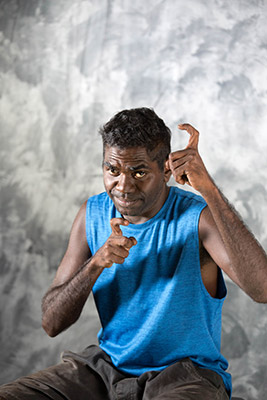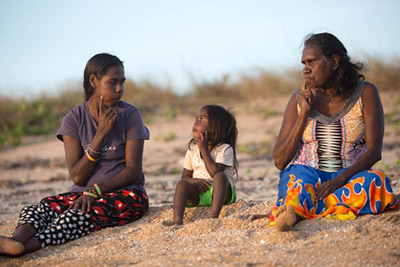Yolŋu Sign Language (YSL) is a unique, endangered sign language of the Yolŋu people of North East Arnhem Land. YSL is not a signed version of the locally spoken language, but an alternate language for hearing Yolŋu. It is the primary language of deaf Yolŋu people. (Adone 2016).
YSL has a rich ancestral heritage in dance, ritual and kinship, reflecting an intimate relationship with the natural world.
In movement and action, in self-expression and song, in deep-rooted tradition and modern constructions, signs are part of everyday, evolving and articulating every aspect of life in bimodal-bilingualism.
Once known as Murngin Sign Language, YSL has evolved to communicate and respond to the unique and complex ritual and religious life of the Yolŋu people. It reflects their intimate relationship with a pre-existing ancestral geography and kin-based view of the universe (Morphy 2008).
With a wide range of applications, YSL is used when speech is culturally forbidden, during periods of mourning, in the presence of sacred objects and at special sites, in interactions around relationships of avoidance and poison kin.
YSL has many practical applications, communicating over distance, for emphasis, for silent and secret exchanges and for the soundless practices of hunting and fishing.
In the past YSL was learned from birth along with spoken language but its intergenerational transmission has been and is increasingly diminished by changes imposed (both deliberately and coincidentally) by the settler state and globalisation.
In 1926 distinguished American anthropologist Lloyd W Warner collected the first seventy signs of YSL on Milingimbi, the largest of the inner Crocodile Islands.
The field of sign linguistics defines ‘bimodal-bilingualism’ as the ability to use both spoken and signed languages to communicate and is common practice in Australian Indigenous societies.
In these societies the hearing population often use several spoken languages (auditory modality) and are also fluent in an Indigenous sign language (visual modality).
It is not clear how bimodal-bilingualism on the Australian continent came to be so ubiquitous, but it may have been born from the continuity of countless generations of life in place, and the changing environment of such places over aeons.
Glaciation, aridification and the uncertain ecological carrying capacity of subsistence economies promoted long distance networks of ritual, marital (connubial) and economic relations.
The ecological and economic circumstances of locality based culture, of indissoluble links to Country, may have stimulated multilingualism, and therefore the conditions for bimodal-bilingualism across geographically distant groups speaking different languages (James 2019, James, Adone and Bruk 2019).
Ethnographic and linguistic evidence from the languages of Arnhem Land describe profound linkages between the Yolŋu experience of connection to place, and each other, as kin. It is this singular kin-based universal view and enduring links to a pre-existing ancestral geography that anchor Yolŋu society to their place.
The deep connections of place, of sites, songs and kin, in physical and social space, form a network of relations evident and articulated through the medium of Yolŋu languages and YSL.
The Illustrated Handbook of Yolŋu Sign Language of North East Arnhem Land records in vibrant colour the bimodal metaphors, idioms and signs of the Yolŋu experience of kin and country.
It includes 500 of the most frequently used signs and describes the grammar, vocabulary, structure and conventions of YSL.
Over the past twenty five years the varieties, use, grammar and principles of YSL have been documented by volunteers, with a view to making that research a repository for disappearing signs available to all.
The handbook details, illustrates and teaches the vocabulary, hand shapes and movements, structure and grammar of YSL, with captions and text in Yolŋu and in English.
Images courtesy of Dr Bentley James.

